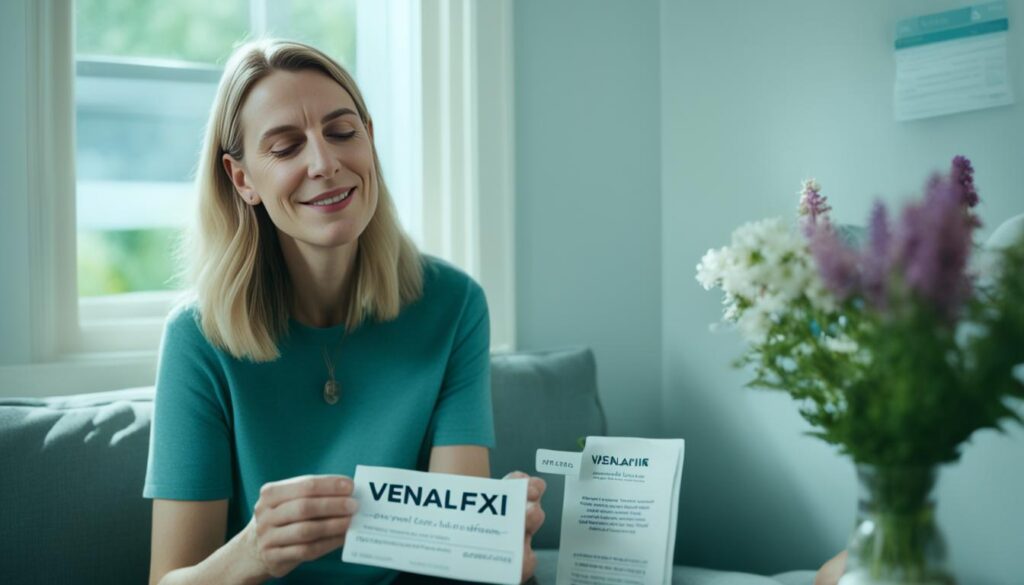Venlafaxine, also known as Effexor, is a common antidepressant in the U.S. It’s an SNRI type of medication. This venlafaxine medication is mainly used for major depression and anxiety issues. These include generalized anxiety disorder (GAD), panic disorder, and social anxiety disorder.
It comes in tablets and extended-release capsules. Venlafaxine helps balance neurotransmitters in the brain. This can help people with mood disorders. It’s important to know how it works, its benefits, and possible side effects for effective treatment. Check out this important overview for more details.
Key Takeaways
- Venlafaxine is commonly prescribed for both depression and anxiety disorders.
- It has been available since 1993, demonstrating its long-standing safety and efficacy.
- This medication may lead to side effects such as nausea and raised blood pressure.
- Careful administration is necessary to avoid withdrawal symptoms upon discontinuation.
- Monitoring and communication with healthcare providers are vital throughout treatment.
What is Venlafaxine?
Venlafaxine is a medicine used to treat depression and anxiety. It belongs to a group called serotonin-norepinephrine reuptake inhibitors (SNRIs). These drugs help increase serotonin and norepinephrine in the brain. The main Venlafaxine uses are for major depression and generalized anxiety disorder. This helps improve mental health.
Before starting Venlafaxine, it’s important to know about its benefits and risks. Some young people taking this drug thought about suicide. So, talking to a doctor is key, especially for those under 18. It’s also important to watch for any changes in mental health during treatment.
Venlafaxine comes in different strengths like 25 mg, 37.5 mg, 50 mg, 75 mg, and 100 mg. The tablets vary in shape and color, making them easy to identify. It’s crucial to talk to your doctor about these details to follow your treatment plan correctly.
Classification of Venlafaxine
Venlafaxine is known as a serotonin-norepinephrine reuptake inhibitor, or SNRI medication. This type of medicine is key to understanding how it works and its effects. It helps by stopping the brain from taking back serotonin and norepinephrine. This can improve mood and help with depression and anxiety.
Venlafaxine is used for many mental health issues, like major depression and anxiety. Knowing its type helps doctors choose the right treatment, dosage, and manage side effects.
Some people’s genes can change how venlafaxine works in their body. For example, certain genes can slow down how the body breaks down the medicine. This can affect how well the treatment works. It shows why treating each person as an individual is important when using venlafaxine.
| Genotype | Effect on Metabolism | Risk of Adverse Events |
|---|---|---|
| CYP2D6*4 | Reduced metabolism | Increased risk |
| CYP2D6*6 | Reduced metabolism | Increased risk |
| Multidrug Resistance Protein 1 (C allele) | Increased likelihood of remission | Increased risk of adverse events |
| Various CYP2D6 Mutations | Poor drug metabolism | Lower dose requirements, side effects include nausea and vomiting |
Understanding venlafaxine’s classification shows its importance in treating mental health issues. It’s a key option for managing different psychiatric conditions.
Venlafaxine Uses
Understanding how venlafaxine works can help patients and doctors make better treatment choices. It’s known for helping with mental health issues, affecting about 30% of people in the U.S. This drug is an important part of treating many psychiatric disorders because it helps manage serotonin and norepinephrine levels in the brain.
Approved Indications
Venlafaxine is approved for treating:
- Major depressive disorder
- Generalized anxiety disorder (GAD)
- Social anxiety disorder
- Panic disorder
The FDA has approved these uses because venlafaxine helps manage symptoms of these conditions. People taking this drug often feel better in terms of mood and anxiety. This leads to a better quality of life for them.
Off-Label Uses
Doctors also use venlafaxine for other conditions, showing its flexibility. Some common off-label uses include:
- Fibromyalgia
- Diabetic neuropathy
- Chronic pain syndromes
- Migraine prevention
- Obsessive-compulsive disorder (OCD)
- Post-traumatic stress disorder (PTSD)
- Premenstrual dysphoric disorder (PMDD)
This shows that venlafaxine can help with more than just mood issues. It can also ease chronic pain and anxiety. This gives hope to those who haven’t found relief with other treatments.
How Does Venlafaxine Work?
Understanding the Venlafaxine mechanism of action shows how it helps with depression and anxiety. It works as a serotonin-norepinephrine reuptake inhibitor (SNRI). This means it stops the body from taking back serotonin and norepinephrine. This leads to more of these important neurotransmitters in the brain.
Having more serotonin and norepinephrine helps improve mood and reduce symptoms of mental health issues. Studies show that taking 150 to 225 mg of venlafaxine daily works best. It helps with pain from diabetic neuropathy and improves life quality when used with gabapentin.
This medicine does more than just help with mood. It also changes how the brain works and reduces inflammation. For people with depression and anxiety, venlafaxine XR works better than some other medicines.
Venlafaxine is also used for social anxiety and hot flashes in breast cancer survivors. Its wide range of uses shows how versatile the Venlafaxine mechanism of action is.

| Study Focus | Findings |
|---|---|
| Painful Diabetic Neuropathy | Effective dosages: 150-225 mg/day, superior to placebo. |
| Combination with Gabapentin | Showed improved pain reduction and quality of life. |
| Major Depression vs. Fluoxetine | Venlafaxine XR demonstrated greater efficacy. |
| Social Anxiety Disorder | Potential alternative treatment. |
| Hot Flashes | Reduction in frequency and severity noted. |
Venlafaxine Dosage and Administration
Getting the right dose of Venlafaxine is key to its success. The dose depends on the condition, age, and other health factors. Knowing the different forms and guidelines helps in treating patients effectively.
Available Dosage Forms and Strengths
Venlafaxine comes in various forms for different needs:
- Immediate-release tablets: 25 mg, 37.5 mg, 50 mg, 75 mg, and 100 mg.
- Extended-release capsules: 37.5 mg, 75 mg, 150 mg, and 225 mg.
Typical Dosage Guidelines
Adults with depression usually start with 75 mg a day. This can go up if needed. For panic disorder, start with 37.5 mg for a week. The highest dose for depression and anxiety is 225 mg a day.
If you miss a dose, don’t take two at once. Always talk to your doctor to adjust the treatment for you.
Specific Patient Populations
Kids start with 37.5 mg, and teens might get 150-300 mg. Be careful with those who have liver or kidney problems. Pregnant or breastfeeding women should talk to their doctors about the risks and benefits.
Following the dosage guidelines and talking with your doctor makes treatment safer.
Venlafaxine Benefits
Venlafaxine is a key player in mental health therapy. It helps manage major depressive disorder and anxiety symptoms. Many people see a big improvement in their life quality, showing its effectiveness in mental health care.
It also has benefits beyond its approved uses. For instance, it can help with fibromyalgia and neuropathic pain. This shows its wide range of uses, not just for mental health.
The more you take venlafaxine, the more it helps by blocking noradrenaline reuptake. This makes it crucial to have treatment plans that fit each patient’s needs. It helps get the most benefits while reducing side effects.
Patients often have better experiences, leading to better talks with doctors about their progress. This makes venlafaxine a versatile choice for doctors.
In short, venlafaxine is great for treating depression, anxiety, and chronic pain. It’s a flexible option for doctors to use in their treatment plans.
Venlafaxine Side Effects
It’s important to know the possible side effects of venlafaxine before taking it. Both mild and severe reactions can happen. Keeping an eye on these effects helps manage health concerns during treatment.
Common Side Effects
Side effects of venlafaxine differ from person to person. Many feel mild effects that don’t need a doctor’s help. These common side effects happen to more than 1 in 100 people:
- Nausea
- Headaches
- Dizziness
- Dry mouth
- Sweating and hot flushes
- Fatigue
- Insomnia
- Constipation
If these symptoms last or bother you a lot, talk to your doctor.
Serious Side Effects
Some people might have serious side effects from venlafaxine, happening to fewer than 1 in 100. These can be very bad and need quick medical help. Serious side effects include:
- Weight changes
- Menstrual irregularities
- Signs of low sodium levels, like persistent headaches and muscle cramps
- Unexplained excessive happiness or restlessness
- Muscle pain or weakness
- Liver problems indicated by yellowing of the skin or eyes
- Visual disturbances
- Blood in cough or urine
- Gastrointestinal bleeding, such as black or red stool
- Shortness of breath or arrhythmias
- Suicidal thoughts
Severe allergic reactions are rare but can cause swelling of the lips or throat, trouble breathing, and skin rash. Taking venlafaxine for a long time is usually safe. But, it might cause sexual side effects like erectile dysfunction or decreased libido.
It’s a good idea to check the medication leaflet for a full list of side effects. If you notice any worrying symptoms, report them through the Yellow Card safety scheme. Knowing about these risks helps with better monitoring and management, making treatment safer.
Venlafaxine Interactions
Understanding venlafaxine interactions is key for both healthcare providers and patients. Many drugs can affect how venlafaxine works, leading to possible side effects. In fact, 687 drugs are known to interact with venlafaxine.
Of these, 151 are major interactions, 532 are moderate, and 4 are minor. This shows how vital it is to know about these interactions before starting treatment. For example, mixing venlafaxine with bepridil is not safe due to serious risks. Also, combining it with levomilnacipran requires caution.
There are also 11 disease interactions with venlafaxine. Elderly patients are at higher risk of side effects, like becoming too sensitive to the drug, which can cause low sodium levels in the blood. Adjusting the dose might be needed to reduce these risks.
Drinking alcohol or eating certain foods can also affect how venlafaxine works. There are 2 interactions related to these substances. Young people, including children and teens, taking venlafaxine should be watched closely for signs of suicidal thoughts.
With so many medications that can interact with venlafaxine, close monitoring by doctors is crucial. This helps ensure patients get the right treatment for their needs safely and effectively.
Venlafaxine Precautions
It’s crucial to know the right precautions for Venlafaxine to ensure safe use. Some contraindications must be considered before giving it to patients.
Contraindications
Avoid giving Venlafaxine to those who are allergic to it. Also, don’t give it to people taking MAOIs or who took them in the past 14 days. Those with certain heart problems need close watch when taking this drug. This helps lower the chance of bad reactions.
Monitoring During Treatment
Venlafaxine monitoring is key during treatment. Regular check-ins let doctors see if symptoms are getting better and watch for side effects. It might take a few weeks to see the best results from Venlafaxine. Keeping an eye on patients helps make changes in treatment quickly if needed. Remember, keeping vitamin B12 levels right is important, as too much folic acid can cause problems. For more on this, check out here.
Venlafaxine Storage and Disposal
Storing Venlafaxine right is key to keeping it effective and safe for patients. Keep it at room temperature, away from light, moisture, and heat. Always use its original container to avoid contamination. Make sure it’s out of children and pet reach to stop them from taking it by mistake.

When it’s time to get rid of unused or expired Venlafaxine, do it carefully. Follow local rules or advice from doctors on how to dispose of it. Here are some ways to safely get rid of it:
- Return it to a drug take-back program.
- Flush it down the toilet only if the label says to.
- Mix it with things you don’t want, like coffee grounds or kitty litter, in a sealed bag, then throw it away.
Make sure the medicine is out of its box and personal info is covered up, if you’re throwing it away in a way that could show who it belongs to. These steps help keep everyone safe and protect the environment.
| Storage Conditions | Disposal Methods |
|---|---|
| Room temperature | Drug take-back programs |
| Away from light and moisture | Mixing with undesirable substances |
| In original container | Flushing as a last resort |
Knowing how to store and dispose of Venlafaxine right keeps it working well and keeps everyone safe.
In Case of Emergency or Overdose
If someone takes too much venlafaxine, get medical help right away. Taking too much can be very dangerous and may cause serious problems like tachycardia, extreme agitation, and seizures. About 12.9% of the time, people who overdose have seizures, according to a study of 953 cases.
When someone takes a lot of venlafaxine, the risk of serious harm goes up. Taking more than 8 grams can hurt the heart badly, leading to conditions like reversible cardiomyopathy. In these cases, doctors might need to use advanced treatments like extracorporeal life support.
Look out for these signs if someone might have overdosed on venlafaxine:
- Rapid heart rate
- QT prolongation and QRS prolongation
- Elevated body temperature
There are ways to treat overdoses, like gastric lavage, activated charcoal, and whole-bowel irrigation. But, it’s important to think about the risks, especially if the person has an unprotected airway or is unstable.
A recent case showed a patient who took 120 extended-release capsules of venlafaxine, which is about 18 grams. This caused severe symptoms, including a very high level of venlafaxine in their blood and a body temperature of 41°C. Doctors used intravenous lipid emulsion to lessen the effects and helped the patient recover fully.
Quick action and the right treatment are key if someone might have overdosed on venlafaxine. Call emergency services or a poison control center right away for help.
| Symptom | Occurrence Rate | Potential Consequences |
|---|---|---|
| Tachycardia | High | Cardiac complications |
| Seizures | 12.9% | Neurological damage |
| QT Prolongation | Significant | Arrhythmias |
| Cardiac Toxicity | Common in large doses | Potential irreversible damage |
Patient Information and Communication
Talking well with healthcare providers is key when taking venlafaxine. Patients should talk openly about their symptoms and worries. It’s important to tell doctors about any side effects to help plan the best treatment.
Knowing how the medicine works can help patients. They should learn about the dosage, how it might affect other medicines, and special things to consider for their health. For example, people with kidney or liver problems might start with a lower dose of Effexor XR.

Patients should share any concerns about side effects or how the medicine interacts with other drugs. Venlafaxine can cause nausea, dizziness, and a faster heart rate. Telling doctors about these issues helps them make changes to the treatment plan if needed.
- Discuss symptoms and medication effects openly.
- Prepare a list of all medications currently being taken.
- Ask questions regarding concerns about side effects.
- Monitor any psychological or physical changes closely.
Working together, patients and doctors can make treatment better. This teamwork makes sure each person’s needs are met while taking venlafaxine.
Brand Names for Venlafaxine
Venlafaxine is known for helping with mental health issues. It goes by several Venlafaxine brand names. Effexor is a top name, available in regular and extended-release forms. Effexor XR lets patients take it once a day, making it easier to stick to the treatment plan.
Knowing the Venlafaxine brand names makes it easier for patients to recognize their medicine. Each brand has its own type and how often to take it. For example, Effexor XR is often the first choice for treating depression and anxiety because it works well and is easy to remember.
Being aware of the Venlafaxine brand names helps avoid mix-ups with different effects and side effects. Even though Effexor and Effexor XR both have the same main ingredient, they work differently in the body. This can change how they help with symptoms.
For better mood and emotional health, adding activities that boost serotonin is key. Things like working out and laughing can really help. You can learn more about this here.
In summary, knowing the Venlafaxine brand names helps with managing medication. It also helps in making better choices about treatment and lifestyle changes.
Conclusion
Venlafaxine is a key medicine for treating mental health issues, mainly as an antidepressant. It works by stopping serotonin and noradrenaline from being taken back by the brain. It also affects dopamine a bit. Finding the right dose is crucial because people react differently to it.
Studies show that Venlafaxine can help with more than just depression. It might also help with psoriasis and panic disorder. Many studies prove it’s more effective than placebos and other treatments. This shows how well it works and why it’s important to watch how it’s used.
Talking openly with doctors about Venlafaxine can make treatment better. Making informed choices and careful monitoring can help use the medicine well. This can greatly improve mental health.


